| Eskiminzin, Aravaipa apache chief |
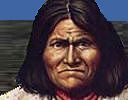 |
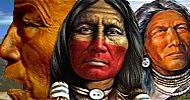 |
|
|
|
||
| N'de, Dinė, Tinde, Inde or "The People" |
| |
Eskiminzin, Aravaipa apache chief |
Artifact Replicas|Jewelry|Clothing|Figurines|On Sale|New ProductsEskiminzin, Aravaipa apache chiefEskiminzin was an important Aravaipa Apache Chief during the Apache Wars. He was instrumental in the negotiations which set the terms which established the San Carlos Reservation. "If it had not been for the massacre, there would have been a great many more people here now; but after the massacre, who could have stood it? When I made peace with Lieutenant Whitman my heart was very big and happy. The people of Tucson and San Xavier must be crazy. They acted as though they had neither heads nor hearts..they must have a thirst for our blood ..These Tucson people write for the papers and tell their own story. The Apaches have no-one to tell their story."Eskiminzin was born about 1828, probably near the Pinal Mountains. He was actually a Pinal Apache, but married into the Aravaipas (south of the Pinals). His father-in-law was Santos, chief of the Aravaipas. His name means "Men Stand in Line for Him". Eskiminzin was an important Aravaipa Apache Chief during the Apache Indian Wars. Eskiminzin was nearly always in very difficult positions trying to save his people. When he felt they had to fight to survive, he was unafraid to do so. When it was better for his people to accept peace terms, he did so. He always had the welfare of his people in mind. In February of 1871, Eskiminzin was tired of the warpath. It was Eskiminzin who finally negotiated the terms by which the San Carlos Apache Reservation was established. He sent five old Apache women to inquire at Camp Grant about peace and protection. Lt. Whitman received the women courteously and worked out an appointed time for a peace talk with their leader. On subsequent meetings, it was arranged for the Indians to stay in wickiups east of Camp Grant. In exchange for the protection and food, the Indians were employed in farming, gathering hay and working for nearby ranches. This worked out well for both the Apaches and the U.S. military. However, after the reservation was established, Eskiminzin and his people experienced real tragedy. It wasn't long before a loose confederation of Anglos, Hispanics and Tohono O'odham Indians from the Tucson basin were fuming about raids in the area, attacks that historically cost livestock and lives. Rightly or wrongly, the group blamed the Aravaipa Apaches and set out to teach them a hard, cruel lesson. The camp was an easy target because its exact location was known and it was relatively close to Tucson. The Tucson group struck at dawn and slaughtered more than 100 Aravaipa and Pinal Indians on the creek. All but eight were women and children. The men were mostly off hunting. This became known as the Camp Grant Massacre. An outraged military put the leaders of the Tucson vigilante group on trial, but they were acquitted. As it turned out, the massacre may have been encouraged by government officials and Tucson businessmen to stir the Aravaipas into seeking revenge. Thus the flow of supplies for the troops would continue as they took the field against the Apaches. Killing was good for business. About a month after the Camp Grant incident, Eskiminizin wanted to show his fellow Arivaipas that there could be no friendship with the white man. Eskiminzin had a close white friend of many years, a rancher named Charles McKinney. Eskiminzin shared an evening meal with McKinney, and at the conclusion of the meal, the two smoked a cigarette together. Upon finishing, Eskiminzin stood up, pulled a revolver from his pants and shot the man at point-blank range, killing him. When Eskiminzin was later asked about the incident, he was quoted as saying, "Any coward can kill his enemy, but it takes a brave man to kill his friend." It's no wonder his reputation caused much fear among the whites. In the summer of 1873 conditions on the reservation reached crisis proportions. Eskiminzin felt it was best that he should flee. He returned four months later because most of his people were sick and starving. Eskiminzin was put in chains. When John Clum arrived, he ordered him released, because Clum felt he had been treated shamefully. Eskiminzin even visited Washington, D.C., with Clum in 1876. Slowly, Eskiminzin began to feel that peace was beginning to pay off. However, in 1887 his son-in-law, the Apache Kid, was arrested for the murder of a rival on the San Carlos Reservation. When the Kid finally escaped, it was believed that Eskiminzin would aid him from time to time. Eskiminzin was arrested in April or May 1891 and sent to Ft. Wingate, New Mexico, with 40 other supposed sympathizers of the Kid. They were forced to join the Chiricahuas who were then at Mt. Vernon, Alabama (before their removal to Oklahoma). Eskiminzin and his San Carlos braves were not exactly on friendly terms with the Chiricahuas, and they found their situation to be very difficult. Finally, a white friend, Hugh Lennox Scott, convinced authorities that Eskiminzin should be released. He arrived back in San Carlos on November 23, 1894. A year later Eskiminzin died. There are still many descendants of Eskiminzin on the San Carlos Reservation. 
Golden Hour of the Superstitions Art Print Klingler,... Buy at AllPosters.com Framed Mounted |
What's New in the Gallery Store: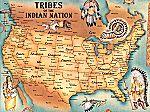 Native American Tribes by States Poster 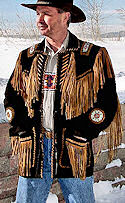 25 new fringed leather jackets 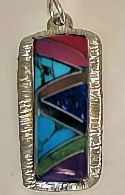 Zuni Style inlaid stone jewelry More New Products |
||||||||||||||||||||||||||||||||||||||||||||||||||||||||||||
Apache chastity and marriage Apache customs regarding courtship, marriage and divorce. Wives and burial place of Geronimo A detailed list of all the wives of Gernonimo and his burial place. Why do we yell "Geronimo"? Learn the legend behind this phrase. Apache tribal amusements, manners, and customs As explained by Geronimo in the telling of his life story.
| |
| Back to Top |Shipping & Return Policies |Customer Testimonials |Site Map |Affiliate Program |Privacy Policy |Contact Us | Submissions |